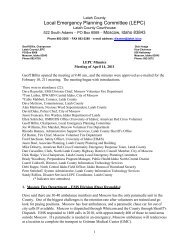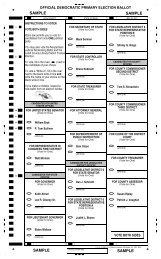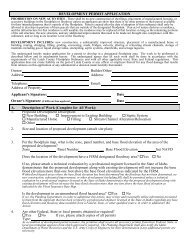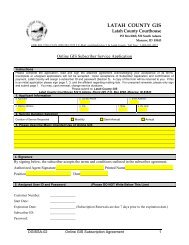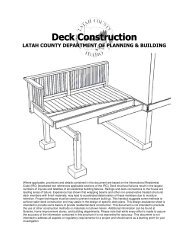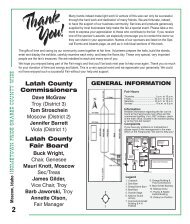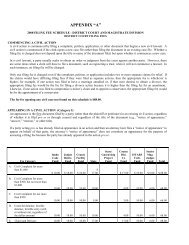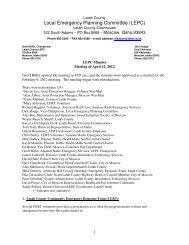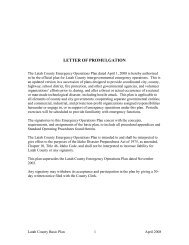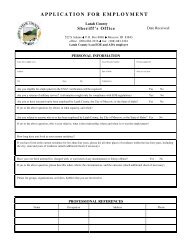LATAH COUNTY, IDAHO MULTI-HAZARD MITIGATION PLAN
LATAH COUNTY, IDAHO MULTI-HAZARD MITIGATION PLAN
LATAH COUNTY, IDAHO MULTI-HAZARD MITIGATION PLAN
You also want an ePaper? Increase the reach of your titles
YUMPU automatically turns print PDFs into web optimized ePapers that Google loves.
The most commonly reported flood magnitude measure is the “base flood.” This is the magnitude of a<br />
flood having a one‐percent chance of being equaled or exceeded in any given year. Although unlikely, “base<br />
floods” can occur in any year, even successive ones. This magnitude is also referred to as the “100‐year<br />
Flood” or “Regulatory Flood” by State government. Floods are usually described in terms of their statistical<br />
frequency. A "100‐year flood" or "100‐year floodplain" describes an event or an area subject to a 1%<br />
probability of a certain size flood occurring in any given year. This concept does not mean such a flood will<br />
occur only once in one hundred years. Whether or not it occurs in a given year has no bearing on the fact<br />
that there is still a 1% chance of a similar occurrence in the following year. Since floodplains can be<br />
mapped, the boundary of the 100‐year flood is commonly used in floodplain mitigation programs to<br />
identify areas where the risk of flooding is significant. Any other statistical frequency of a flood event may<br />
be chosen depending on the degree of risk that is selected for evaluation, e.g., 5‐year, 20‐year, 50‐year,<br />
500‐year floodplain.<br />
The areas adjacent to the channel that normally carry water are referred to as the floodplain. In practical<br />
terms, the floodplain is the area that is inundated by flood waters. In regulatory terms, the floodplain is the<br />
area that is under the control of floodplain regulations and programs (such as the National Flood Insurance<br />
Program which publishes the FIRM maps). The floodplain is often defined as:<br />
“That land that has been or may be covered by floodwaters, or is surrounded by floodwater and<br />
inaccessible, during the occurrence of the regulatory flood.” 24<br />
Winter weather conditions are the main driving force in determining where and when base floods will<br />
occur. The type of precipitation that a winter storm produces is dependent on the vertical temperature<br />
profile of the atmosphere over a given area. Latah County experiences riverine flooding from two distinct<br />
types of meteorological events; spring runoff and winter rain‐on‐snow events.<br />
The major source of flood waters in Latah County is normal spring snow melt. As spring melt is a “natural”<br />
condition, the stream channel is defined by the features established during the average spring high flow<br />
(bank‐full width). Small flow peaks exceeding this level and the stream’s occupation of the floodplain are<br />
common events.<br />
Unusually heavy snow packs or unusual spring temperature regimes (e.g. prolonged warmth) may result in<br />
the generation of runoff volumes significantly greater than can be conveyed by the confines of the stream<br />
and river channels. Such floods are often the ones that lead to widespread damage and disasters. Floods<br />
caused by spring snow melt tend to last for a period of several days to several weeks, longer than the floods<br />
caused by other meteorological sources.<br />
Floods that result from rainfall on frozen ground in the winter, or rainfall associated with a warm, regional<br />
frontal system that rapidly melts snow at low and intermediate altitudes (rain‐on‐snow) can be the most<br />
severe. Both of these situations quickly introduce large quantities of water into the stream channel system,<br />
easily overloading its capacity.<br />
24 FEMA. Federal Emergency Management Agency. National Flood Insurance Program. Washington D.C. Available<br />
online at www.fema.gov.<br />
44



